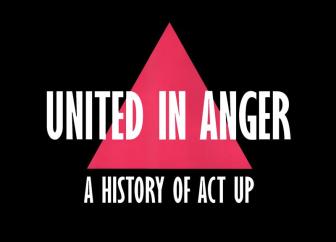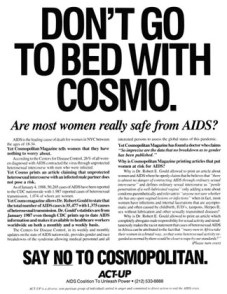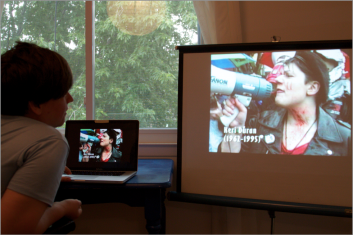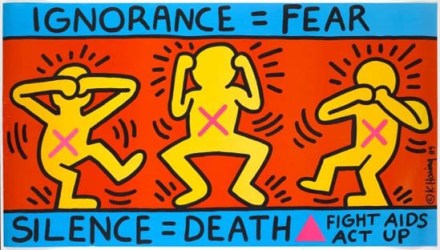By: Gabby and Jamie
 First and foremost, this film is about fighting for your loved ones. Sometimes we don’t get that chance and it burns in an unextinguishable way and we’re left smoldering in the ashes of what could have been. It’s why we cry reading about bullied teens pushed to suicide or baby dykes in love being gunned down in a park. We always wish we could have been there to protect them and somehow kept them safe and alive. They are our family and we mourn them as such.
First and foremost, this film is about fighting for your loved ones. Sometimes we don’t get that chance and it burns in an unextinguishable way and we’re left smoldering in the ashes of what could have been. It’s why we cry reading about bullied teens pushed to suicide or baby dykes in love being gunned down in a park. We always wish we could have been there to protect them and somehow kept them safe and alive. They are our family and we mourn them as such.
This idea is part of what fuels the unending love-based tension throughout United in Anger. The viewer is thrown right into the living hell that was the AIDS epidemic in NYC circa the 1980s. Now maybe that’s not somewhere you’d ever want to be. Well, we’re imploring you to take the ride. Jamie and I screened this film, initially to write a movie review, and ended up experiencing queer history in the most relevant and visceral way. Both of us in different spaces, crying and having all of the feelings about people we’d never met, dying right before our eyes.
But that’s not the sole point of United in Anger. It’s so much grander than that; it’s about witnessing the trauma inflicted upon your family – the queer one created to perhaps replace a biological one that may or may not be supportive of your life – and getting off your fucking ass and doing something real about injustice. It’s about Acting Up because anything else is non-action, complacency and contributing to the decimation of your people.
So what the hell do you do? DOCUMENT. United in Anger is built primarily on footage collected by the ACT UP Oral History Project. ACT UP is the organization created by a multitude of individuals who refused to let their people die from AIDS without a fight. The OHP is the collection of their stories. United in Anger is what’s created when impassioned individuals arm themselves with cameras and are unafraid to point them at a silent government profiting from body counts, at a police force instructed to apprehend and arrest peaceful protestors, and at each other, so that AIDS has a face and that face looks like every single one of us. United in Anger informs us that between 1981 and 1987 over 40,000 people died of AIDS in the United States. Some of those people are in this film and you are forced to look them in the eye as they tell their story. Many of them do not make it to the film’s end. One of the most wrenching editing devices used by Editor Ali was the inclusion of birth and death dates for all the film’s interviewees. Jim Hubbard, the director of UiA, requested this device. The dates are there to let you know that this shit was real; those people were here and many of them chose to document themselves fighting with their ACT UP family for universal health care and the right to live. The act of documenting in a way creates everlasting life because stories only die when people stop telling them. Spirits only die when people stop remembering them.
All of these people. All of their voices. One group. One movie. 200-300 people, many of whom had never been activists in their lives, showed up ready, in desperate need of a safe space to discuss their grief, anger and desire to mobilize. A speech given by American playwright and LGBT/public health activist, Larry Kramer, in the meeting room at the LGBT Center in NYC was the explosive impetus behind ACT UP’s formation; it was the first time someone publicly rallied for something to be done about the AIDS epidemic because it was killing people; it was stripping people of their of their family in such rapid succession and Larry Kramer refused to be silent. His speech was given at a general meeting and soon ACT UP’s numbers grew. But United in Anger is able to weave in all of the people and their groups and their stories into one seamless narrative which is why there is no voiceover in the film. The score is also limited in respect to the importance of the words themselves. Also, Editor Ali made it a point to showcase the many voices from the various “affinity groups” within ACT UP. She said it was to highlight the notion that, “everyone’s struggle is your struggle.” Fucking Amen to that, Ali.
United in Anger isn’t just a film, it’s a teaching tool for future activists. Those future activists are us. Maybe life doesn’t feel like that sometimes. We’re so busy trying to figure out all of the things: gender identities, hormone therapies, binding techniques, which shoes match this outfit, which rally to rally behind, what’s the proper pronoun for our soul, how to tell parents about impending gayness and where the hell we fit in. All of these things make it easy sometimes to feel isolated or disconnected from the whole of our community. Forgive the generalizations, these could just be my feelings. But where we may sometimes feel isolated, United in Anger reminds us of the power of community, of solidarity. The film may begin with afflicted gay men but the addition of a multiplicity of voices allows us to witness the evolution of the movement. Lesbians were being affected by AIDS. Also, straight up, WOMEN, just women. Cosmopolitan magazine ran a story during that time that basically said women couldn’t get AIDS. They were wrong. Women did get HIV and AIDS, as did the homeless, and the queers of color, and straight people and mothers and sons and daughters and you get the point, right? That no matter how we identify, we must remember to be United in our Anger because that is how you get shit done.
 Cosmo’s article (among other things that you’ll learn when you watch this film) pushed ACT UP to organize and protest against the misinformation being spread about AIDS and its impact on women. They flooded the Center for Disease Control with their fists and faces in the name of women’s health. Initially the CDC’s definition of AIDS did not allow for women to receive treatment. Why? Because AIDS manifests itself differently in women than in men. Did you know that? I sure didn’t. Do you even need another reason to see this film?
Cosmo’s article (among other things that you’ll learn when you watch this film) pushed ACT UP to organize and protest against the misinformation being spread about AIDS and its impact on women. They flooded the Center for Disease Control with their fists and faces in the name of women’s health. Initially the CDC’s definition of AIDS did not allow for women to receive treatment. Why? Because AIDS manifests itself differently in women than in men. Did you know that? I sure didn’t. Do you even need another reason to see this film?
One of the elements of the film that Jamie and I both loved so much was the way that in the middle of so much pain it was still able to capture moments of joy. I know the words “fighting” and “dying” probably came up about one million times in this piece but I don’t want you to feel like that is what this entire film is about. Again, we come back to the word family. This is something I feel like we instinctively understand as a queer community; we know about spaces you create online, or in writing, or in real life to come together as a family. United in Anger has these adorable “activism after dark” moments where you see people who’ve been fighting death and despair with each other, take well needed breaks into each other arms, into pools on NYC rooftops and into each other’s beautiful love-filled hearts and bodies. Sex, with safety first, of course, is one of the other secret/awesome tools to keep a movement going. It was important for the film’s producers, Jim Hubbard and Sarah Schulman, to incorporate this irreverent side of the ACT UP community in the film and Editor Ali blended it in in such an honest and completely natural way.
So go see the film , no question. Jamie and I each wanted to share our impressions of the film with you, but you need to see it for yourself. Until you get a chance, here’s what we thought:
Gabrielle: I grew up in this world where AIDS was the devil’s disease and could strike one dead in an instant. It was a threat on the playground and the mark of lepers deserving of their affliction. AIDS was this scary monster that claimed the life of my cousin, Philip. Aside from his funeral, the only memories I have of that time are of watching my great aunt, grandmother and other relatives sew pieces of patchwork for section of AIDS quilt in his memory. I had no idea as a kid that people were waging political war against it and against the powers that allowed it to devour entire segments on the unwanted people or as UiA says they were described as the “convenient populations.” I cried for most of the time I watched this film. I don’t do well with depictions of actual pain and suffering. Editor Ali is my friend and I was lucky enough to view the film in her home with ready access to tissues, a glass of water and hugs.

Ali Cotterill at work.
Seriously, though, ACT UP is a new organization to me. I’d honestly never heard of them before viewing this film. Like I said, AIDS history is centered on a completely different narrative in my life. So in between silent tears streaming down my cheeks, I saw what it was like for queers to come together in desperation and create a movement for all people. I wondered if my great aunt, Titi Carmen, knew of ACT UP, if she would have rallied with them. If she would have brought Philip’s ashes to The White House as a call to action, like so many others were forced to do towards the end of the 80s. These people were her family too and mine and it was hard to keep any emotional distance from this film. I sat for awhile after the film was over mainly to collect myself, dry my face and fucking have a moment to think. How did I make it through high school and college without this knowledge of a crisis that happened in my city? Why do they, the powers that be, keep this shit from us? Would they really rather we all die off? This is why documenting and organizing our struggles is so important. We need to be the ones telling our stories, forever, so that they live beyond us which is what makes United in Anger so fucking powerful. It will live forever and hopefully be used to educate and show people what can happen when we work together. Really, right now reserve your tickets and/or get this film to your school. There is no excuse. Also, I love you all so fucking much and thank you, Ali Coteril, for sharing your thoughts, home and editor’s notes with me.
Jamie: With the 20th anniversary of ACT UP and the OWS/ACT UP action I learned a little bit about ACT UP but it wasn’t until this film that I saw footage of any of the demonstrations. So many of the actions moved me to tears, including the “die in” in protest of the Catholic church in NYC. Perhaps the most devastating part of the film to watch were the protests where those who lost their loved ones marched the ashes to the White House lawn and threw them over the fence in an act of desperation.
Many were lost during the early years of the epidemic and ACT UP refused to let people hide from the reality of the rate at which people were dying from the mystifying disease. Their controversial and intelligent direct action changed the paradigm for protesting. By putting a face to the disease, members of ACT UP refused to let the epidemic continue to be misunderstood and ignored. Watching these actions I see how the work of these activists has impacted future generations and have a new found respect for our far we’ve come in fighting AIDS to say nothing of the lengths activists have gone to create the LGBTQ community I now celebrate. The release of this film during a time when universal health care is still being debated in the United States also strikes me as highly relevant. This film is testament to the need to reform our dysfunctional health care system and provide affordable health care for all.
Quad Cinema is screening the film from July 6th – 12th and you can visit the film’s website to learn about more screenings including at Outfest and the world premiere screening at MoMA.





That video gave me chills.
This was a beautiful review. I wish I lived in larger/more centralized centres so I could actually see all of these amazing documentaries, but my list of things to see at a later time is getting bigger.
This sounds like my kind of documentary. I’ll also have to wait to see it because I live in a cultural wasteland.
Related: I definitely recommend watching the 1989 documentary Common Threads: Stories from the Quilt.
http://en.wikipedia.org/wiki/Common_Threads:_Stories_from_the_Quilt
Amazing. Thanks for the share, I’ve got to see this now, that trailer alone made me cry. Also Rachel Maddow worked with ACT UP after she got out of college, in case you needed another reason to love their activism :)
There is a good PBS documentary about AIDs epidemic in SF, it’s on netflix now, it’s called “we were here”.
Hey, if you live in a cultural wasteland or small town or rural area and want to organize a screening, even in someone’s living room, go to the film’s website http://www.unitedinanger.com and we will help you set something up. Sarah S.
Does this apply to other countries as well? I would love to see this and I know a lot of my friends would too.
“everyone’s struggle is your struggle.”
Further reading/listening:
http://www.npr.org/2012/07/05/156292172/aids-in-black-america-a-public-health-crisis
Survival is an act of resistance (free Cece!) and healthcare is indeed a fucking right.
I’m skipping work on Thurs and running to the Quad to see this…I was a baby dyke, but still aware of what was happening at that time. I remember all of my friends walking around with the Silence = Death pins and shirts. We went as far as spray painting it on walls near a famous ivy league school (*cough-harvard-cough*). Pride was more of an activist event and we bonded with our gay boy brothers. Thankfully, we have the Revel and Riot people to remind us of our Act Up days. Don’t get me wrong, I had a blast at this year’s Pride, but it has a different meaning. Progress is proof that we made a difference.
fucking wonderful.
Incredible review, incredible documentary.
Is there anyway I can get my hands on this in Australia?